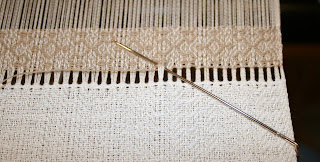 |
| Bruce on his Kubota |
There seems to have been some confusion with regards to what I tried to show you in my previous post. I think it might stem from me perhaps not showing the bottom edge of the towel and the dividing half inch of waste yarn between towels (?) Some thought I might be cutting the towels apart between the hemstitching.... er, nope!
I would ask you to please ignore for the time being all aspects of the actual project (yarns, sett and pattern) for now. That will be all revealed to you once they are off the loom and finished. We'll do a full show and tell then, including the draft. For now let's just focus on the techniques being shown. If I'm not clear enough with my descriptions, please email me at weeverwoman at yahoo dot com. I am trying my best though! I have a whole new respect for weavers who write how-to books! (Such patience!!)
Here is a picture of a fully finished and hand hemmed guest towel I wove from a previous project to give you an idea of what we are trying to accomplish here:
I would like to take our previous hemstitching demo a bit further and show you another technique I've used before with good success. It might be a good idea to click on this link and reread the previous post and get back up to speed on our previous discussion.
As described in the previous post I have woven half an inch of scrap yarn to separate each towel woven, then I wove two inches for my hem allowance and hemstitched every six ends. I slipped in my handy spacer yarn and then after playing with the treadling repeat a bit, I wove a medallion style pattern. It has a row of border treadling 1 to 8, then one little pattern repeat that I made sure reversed nicely, then a border row treadled 8 to 1. I wanted this to be a complete little section, or panel all to its self and you'll see why in just a minute. In the picture above I'm ladder hemstitching and working on the top row. Clicking on any of the pictures will enlarge them for better detail.
Then using the weft tail I left at the end of the pattern repeat, I hemstitch the top edge portion as well.
Next, I have placed my spacer in again and leaving a weft tail (approx weft yarn four times the width of the warp) I weave a border row and the regular pattern repeat. We'll pause the weaving here for now and pull the spacer out. I hold the left edge steady and pull the cord/ spacer yarn out slowly from the right.
Then for the fourth row, we hemstitch again! Then we resume our weaving of the rest of the towel. What I do at the end of the towel is to revert back to my hem colour and weave another 2" in white. You could just use the same colour as the towel and weave a border repeat by way of hem allowance. Its all a matter of choice. I do not hemstitch this end out of choice. Just picture the towel neatly folded on the counter with the fancy hemstitching facing up. For guest towels I only hemstitched the leading presentation edge.... but you can hemstitch the last hem if you like.
A note on sewing the hems: I always handsew small towels and runners, traycloths and even some kitchen towels. I'm not much of a machine sewer and I find that handsewing produces a 'no line look' that I prefer. I do machine sew some towels but try to 'stitch in the ditch'.
I normally only do something like this panel hemstitching technique on narrow projects such as these guest towels or something very special such as a runner. Its gorgeous on the ends of a scarf! Yes, it is time consuming but it adds so much to a project! Guest towels are something special that you lay out by the bathroom vanity when you have guests in your home, or give as a gift. What better way to showcase what you do by a few extra special touches? Once these are off loom, hemmed and wet finished, and well pressed.... they will showcase you as a weaver!
I'm weaving along slowly and wish this warp was complete and off the loom to show you how they will look!
Let me leave you with a view of Maple Mountain after our first major snowfall. Its worth clicking on to see larger.
Weather forecast is in... more snow this week as two fronts collide over us! Tractor Man is at the ready...




























